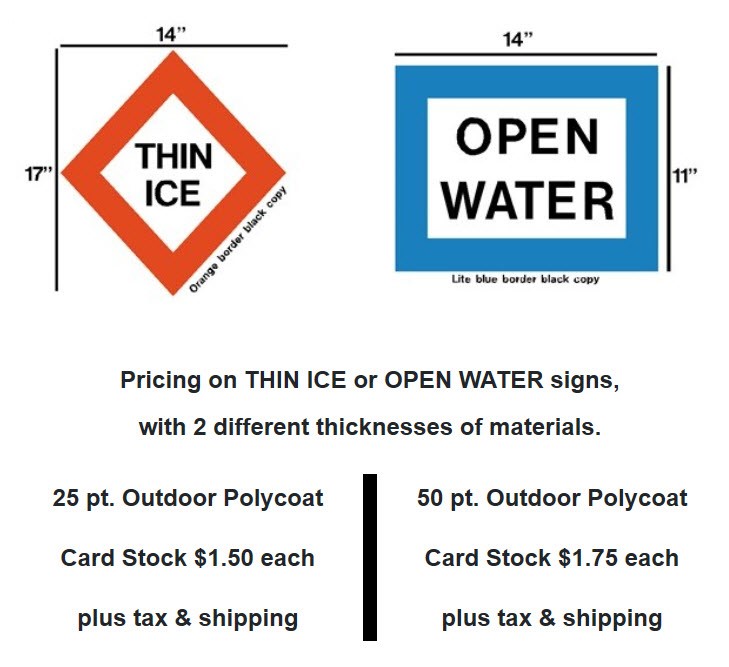Thin Ice Signs

Some information from a pdf brochure published by the Minnesota DNR on ice safety:
http://files.dnr.state.mn.us/education_safety/safety/ice/dangerthinice.pdf
When is ice safe? There really is no sure answer. In fact, ice is never 100 percent safe. You can’t judge the strength of ice just by its appearance, age, thickness, temperature or whether or not the ice is covered with snow.
Strength is based on all these factors — plus the depth of water under the ice, size of the water body, water chemistry and currents, the distribution of the load on the ice and local climatic conditions.
SOME COLD FACTS ABOUT ICE
New ice is usually stronger than old ice. Four inches of clear, newly-formed ice may support one person on foot, while a foot or more of old, partially-thawed ice may not.
Ice seldom freezes uniformly. It may be a foot thick in one location and only an inch or two just a few feet away.
Ice formed over flowing water and currents is often dangerous. This is especiallt true near streams, bridges and culverts. Also, the ice on outside river bends is usually weaker due to the undermining effects of the faster current.
The insulating effect of snow slows down the freezing process. The extra weight also reduces how much weight the ice sheet can support. Also, ice near shore can be weaker than ice that is farther out.
Booming and cracking ice isn’t necessarily dangerous. It only means that the ice is expanding and contracting as the temperature changes.
Schools of fish or flocks of waterfowl can also adversely affect the relative safety of ice. The movement of fish can bring warm water up from the bottom of the lake. In the past, this has opened holes in the ice causing snowmobiles and cars to break through.
ICE TIPS
Think in terms of the thermometer rather than the calendar when deciding to go out on the ice. Just because it was okay on December 1 to go out on the ice last year, doesn’t mean it’s going to be safe on the same date this year.
Check with a local resort or bait shop about any known danger spots such as aeration systems or traditionally unsafe areas before heading out on the ice.
Have a plan of what to do if you do break through. Carry rope, ice picks and a flotation device to help save your life or that of a companion. During the winter of 2000, an ATV operator who broke through thin ice used a pair of ice picks to save his own life. A vest-style life jacket can provide extra warmth and flotation in case you fall through.
DRIVING ON ICE?
Don’t drive on the ice if you can possibly avoid it. If you must, follow these common sense tips:
Stay off the ice at night, especially during a snowfall. If that’s unavoidable, be very cautious and drive slowly since holes can open up very quickly. If you drive too fast you might not be able to stop in time.